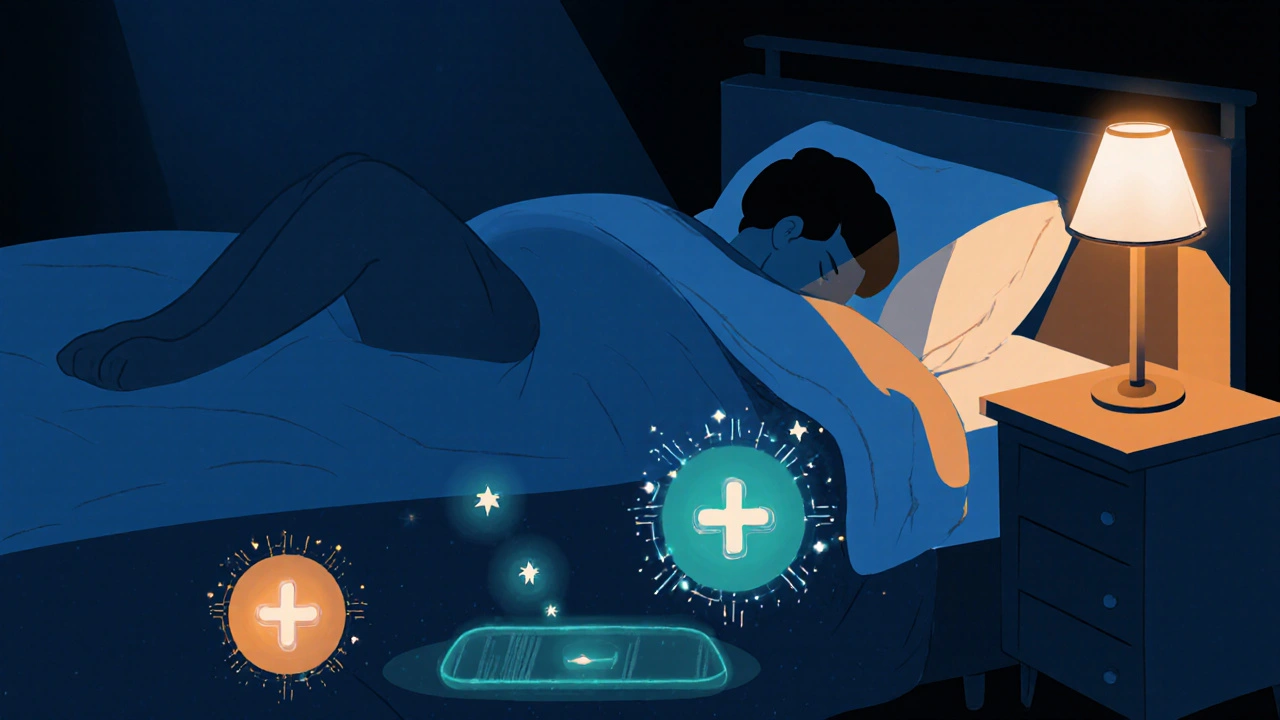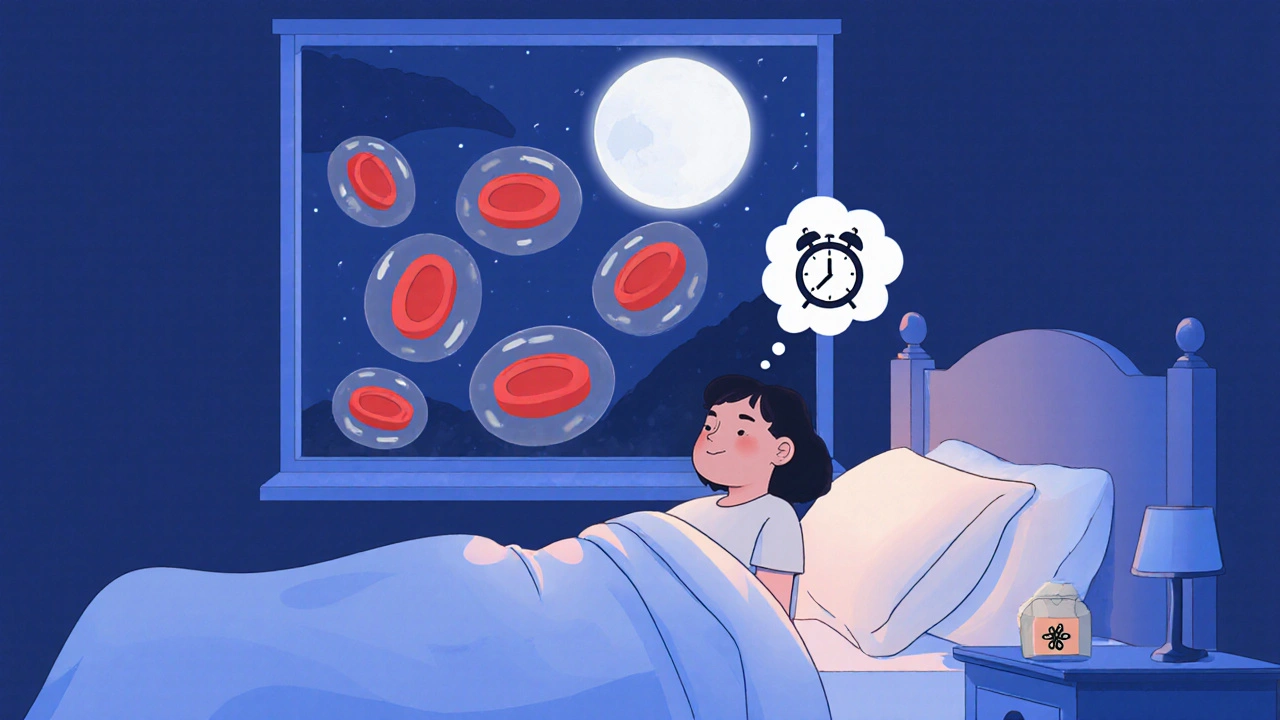Anemia Sleep Risk Calculator
How Anemia Affects Your Sleep
Answer the questions below to assess your risk of anemia-related sleep disruption. Low iron levels can lead to restless sleep, fatigue, and other symptoms that interfere with quality rest.
When you wake up feeling exhausted despite a full night in bed, the culprit might be more than just a bad mattress. anemia can silently sabotage your sleep, leaving you restless and drained. In this guide we’ll unpack how low iron levels interfere with the sleep cycle, what signs to watch for, and practical steps to restore deeper, more refreshing rest.
What is Anemia?
Anemia is a condition characterized by a reduced number of red blood cells or lower-than-normal hemoglobin, the protein that carries oxygen throughout the body. The most common form, iron‑deficiency anemia, occurs when the body lacks enough iron to produce adequate hemoglobin. Without sufficient oxygen, organs-including the brain-struggle to function optimally, which can ripple into sleep disturbances.
How Iron Deficiency Disrupts the Sleep Cycle
The link between iron and sleep isn’t obvious, but several physiological pathways explain the connection. Iron is a co‑factor for enzymes that synthesize neurotransmitters like dopamine and serotonin, both of which regulate wakefulness and the production of melatonin, the hormone that signals nighttime.
When iron stores dip, dopamine production falls, which can trigger restless leg syndrome (RLS) and periodic limb movements during sleep-both major causes of fragmented sleep. Low serotonin levels also interfere with the natural rise of melatonin, delaying the onset of deep sleep stages.
Key Sleep‑Related Symptoms of Anemia
- Frequent awakenings or difficulty staying asleep
- Restless legs or tingling sensations at night
- Excessive daytime sleepiness despite adequate time in bed
- Morning headache or brain fog
- Shortness of breath during night‑time activities, such as turning over in bed
These symptoms often mimic primary sleep disorders, which makes proper diagnosis essential.
Distinguishing Anemia‑Related Sleep Issues from Primary Sleep Disorders
| Feature | Anemia‑Related Issues | Obstructive Sleep Apnea (OSA) | Restless Leg Syndrome (RLS) |
|---|---|---|---|
| Primary cause | Low hemoglobin & iron | Airway blockage | Neurological / iron deficiency |
| Typical night symptom | Frequent awakenings, tingling | Snoring, gasping | Urge to move legs |
| Daytime effect | Fatigue, concentration lapses | Morning headaches, sleepiness | Restless feeling, anxiety |
| Diagnostic test | Blood test (hemoglobin, ferritin) | Polysomnography | Clinical interview, iron labs |
| Treatment focus | Iron supplementation, diet | CPAP, weight loss | Iron, dopamine agonists |
Notice how anemia shares symptoms with both OSA and RLS, but the underlying cause and lab findings differ. A simple Blood test can confirm iron status and steer you toward the right treatment.

Diagnosing Iron‑Related Sleep Problems
Healthcare providers typically start with a complete blood count (CBC) to check hemoglobin levels. If anemia is confirmed, they’ll order iron studies-most importantly serum ferritin, which reflects stored iron. A ferritin level below 30µg/L usually indicates deficiency, though the exact cutoff can vary.
In addition to lab work, doctors may ask about sleep habits, limb sensations, and daytime fatigue. Tools like the Pittsburgh Sleep Quality Index help quantify sleep quality, while questionnaires such as the Restless Legs Syndrome Rating Scale pinpoint RLS severity.
Effective Strategies to Improve Sleep When You Have Anemia
Once iron deficiency is identified, the main goal is to restore healthy iron stores. Here are evidence‑backed steps that also boost sleep:
- Iron supplementation: Oral ferrous sulfate 325mg (equivalent to 65mg elemental iron) taken on an empty stomach maximizes absorption. Some people experience stomach upset; if so, a low‑dose or a heme‑iron product may be gentler.
- Pair iron with Vitamin C (e.g., a glass of orange juice) to enhance absorption by up to 2‑fold.
- Space calcium‑rich foods or supplements at least two hours apart from iron, as calcium can block uptake.
- Include iron‑rich foods daily: lean red meat, poultry, lentils, spinach, and fortified cereals. Cooking in a cast‑iron skillet adds an extra iron boost.
- Address RLS directly: If limb sensations persist after iron levels normalize, a low dose of a dopamine agonist (e.g., pramipexole) may be prescribed.
- Maintain a consistent sleep schedule. Going to bed and waking up at the same time anchors melatonin release, which is already compromised by low serotonin.
- Limit caffeine and heavy meals close to bedtime, as they can worsen restless sensations.
- Consider a short (<30min) evening walk. Light exercise improves circulation, reducing leg cramps that often accompany anemia.
Most people notice sleep improvement within 2-4 weeks of correcting iron levels. A follow‑up ferritin test is recommended after 8 weeks to ensure the deficiency is resolved.
When Anemia Might Mask a More Serious Sleep Disorder
While iron deficiency is a common, treatable cause of poor sleep, it can coexist with other conditions. For instance, untreated obstructive sleep apnea can cause chronic fatigue that mimics anemia‑related tiredness. Conversely, severe anemia can worsen hypoxia during apnea episodes.
If you continue to snore loudly, experience witnessed pauses in breathing, or have a high body‑mass index, a sleep specialist should evaluate you for OSA regardless of your iron status.

Long‑Term Lifestyle Tips for Maintaining Healthy Iron Levels and Good Sleep
- Schedule regular blood work-especially for women of childbearing age, vegetarians, and older adults.
- Eat a balanced diet that pairs plant‑based iron (non‑heme) with vitaminC‑rich foods.
- Avoid excessive tea or coffee during meals; tannins can inhibit iron absorption.
- Stay physically active-moderate exercise improves both circulation and sleep quality.
- Manage stress through mindfulness or gentle yoga; high stress can elevate cortisol, which disrupts sleep and may affect iron metabolism.
By integrating these habits, you protect both your hematologic health and your nightly rest.
Quick Checklist: Spotting Anemia‑Related Sleep Problems
- Do you wake up multiple times per night?
- Are your legs twitchy or uncomfortable at bedtime?
- Do you feel unusually tired after a full night’s sleep?
- Have you had a recent blood test showing low hemoglobin or ferritin?
- Is your diet low in iron‑rich foods?
If you answered yes to several of these, talk to your healthcare provider about a complete blood count and iron studies.
Frequently Asked Questions
Can iron supplements cause insomnia?
Iron itself isn’t a stimulant, but some people experience stomach discomfort that can make it hard to fall asleep. Taking the supplement on an empty stomach with a small amount of vitaminC, or switching to a slower‑release formula, often resolves the issue.
How long does it take for sleep to improve after treating anemia?
Most patients notice fewer night‑time awakenings within 2-4 weeks of restoring iron levels. Full recovery of sleep architecture may take up to 8 weeks, depending on the severity of the deficiency.
Is restless leg syndrome always caused by iron deficiency?
Iron deficiency is a common trigger, especially in women and older adults, but RLS can also stem from genetics, kidney disease, or certain medications. Testing ferritin helps determine if iron is the culprit.
Should I get a sleep study if I have anemia?
Start with a blood test. If iron levels are normal but sleep problems persist, or if you have classic apnea signs (snoring, witnessed pauses), a polysomnography is warranted.
Can diet alone raise my ferritin enough to fix sleep?
Mild deficiencies can often be corrected with iron‑rich foods plus vitaminC. Moderate to severe anemia usually requires supplemental iron for a faster, reliable rise in ferritin.

Comments (6)